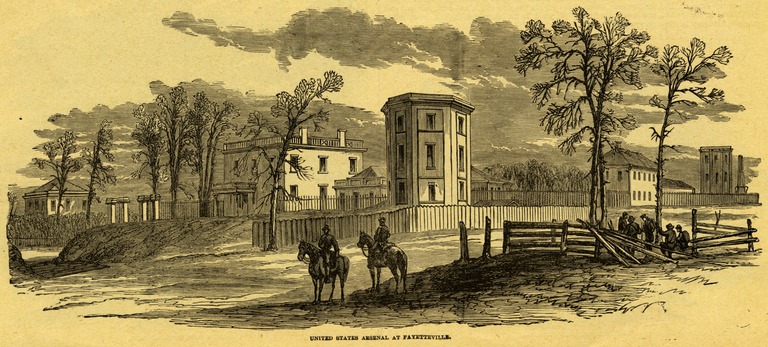Bell, William (1789-1865)
Birthplace:
Aberdour, Scotland
Residences:
- Fayetteville, North Carolina
Trades:
- Architect
- Builder
NC Work Locations:
Building Types:
William Bell (Oct. 28, 1789-Sept. 17, 1865), one of many Scots builders active in America, spent much of his career as architect of the United States Arsenal in Fayetteville, North Carolina, where in 1861 the local newspaper cited him as “the Architect who has supervised the erection of all the buildings, from the founding of the Arsenal.”
A native of Aberdour, Fifeshire, near Edinburgh, Bell is said to have trained in medicine and architecture at the University of Edinburgh. He married Margaret Robinson by 1826, and they had several children. Family tradition states that he immigrated to America in 1833 and worked in construction of a Federal arsenal near Yonkers, New York, then in Washington, D.C., and possibly in Charleston, South Carolina in association with architect William Strickland. In 1835, while at a quarry in East Chester, New York, Bell inquired about work prospects from David Paton, a friend and fellow Scotsman then supervising construction of the North Carolina State Capitol in Raleigh. In 1837, Paton recommended Bell as master builder for the new United States Arsenal in Fayetteville, a major facility for storage, repair, and manufacture of arms. Captain J. A. Bradford, officer at the facility, went north to recruit skilled workers, including Bell for masonry and George Hodges for carpentry at $4 per day. Work began in 1838.
At the arsenal, in addition to providing designs, Bell supervised the manufacture of millions of bricks, the operation of a sandstone quarry, and the work force of bricklayers, stonemasons, and laborers—nearly 200 by 1839. The complex was a square 500 feet on a side, with towers at the corners, and it comprised about twenty-five buildings. Bell and his family resided at the arsenal. During a lull in construction, Bell provided drawings (1839) for buildings at the University of North Carolina at Chapel Hill, but they were not executed. After the Confederacy took over the arsenal in 1861, he supervised construction of additional buildings. In 1865, troops of General William T. Sherman destroyed the arsenal. Bell died that September, supposedly of a broken heart, after seeing the destruction of his life’s work.
- CAI, “N. C. Arsenal, Fayetteville, Historical and Salvage Archeological Study, for North Carolina Division of Archives and History” (1973).
- Cumberland County Records, North Carolina State Archives, Raleigh, North Carolina.
- David Paton Papers, North Carolina State Archives, Raleigh, North Carolina.
- David L. Swain Papers, North Carolina State Archives, Raleigh, North Carolina.
- Mena Webb, “William Bell,” in William S. Powell, ed., Dictionary of North Carolina Biography, 1 (1979).
United States Arsenal
Contributors:William Bell, architect and builder (1838-1865); George Hodges, carpenter; William Murdoch, attributed stonemasonDates:1830s-1860s
Location:Fayetteville, Cumberland CountyStreet Address:Fayetteville, NC
Status:No longer standing
Type:Military
Images Published In:H. G. Jones, North Carolina Illustrated, 1524-1984 (1983).

